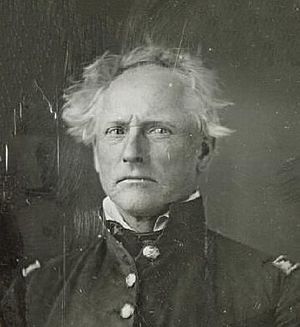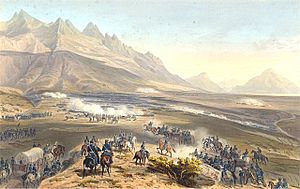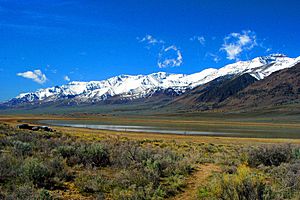Enoch Steen facts for kids
Quick facts for kids
Enoch Steen
|
|
|---|---|

Major Enoch Steen
|
|
| Born | February 22, 1800 Harrodsburg, Kentucky |
| Died | January 22, 1880 (aged 79) Jackson County, Missouri |
| Allegiance | |
| Service/ |
|
| Years of service | 1832–1866 |
| Rank | |
| Unit | 1st United States Dragoons; 2nd United States Cavalry |
| Commands held | Fort Webster (New Mexico); Fort Buchanan (Arizona); Fort Walla Walla (Washington); Union Army fort at Sandy Hook (New York Harbor); Fort Lyon (Colorado) |
| Battles/wars | Battle of Buena Vista; Indian skirmishes; American Civil War |
| Signature |  |
Enoch Steen (born February 22, 1800 – died January 22, 1880) was a brave U.S. Army officer and explorer. He joined the Army in 1832. He served at many places across the United States. This included many far-off locations in the western part of the country.
During his time in the Army, Steen explored large areas. These included southern New Mexico and southeastern Oregon. He also led several forts for the Union Army during the American Civil War. Today, many places are named after him. These landmarks are in Oklahoma, Oregon, and New Mexico. Sometimes, his name is spelled "Stein" on maps.
Contents
Early Life and Army Start
Enoch Steen was born in Harrodsburg, Kentucky, on February 22, 1800. He was the third of five children. His family moved to Missouri when he was young. Growing up on the American frontier, Steen became a skilled woodsman and hunter.
As a young man, Steen worked as a surveyor. This job involves measuring land. On July 16, 1832, he joined the Mounted Rangers. He started as a second lieutenant.
Adventures as a Junior Officer
On September 19, 1833, Steen joined the 1st United States Dragoons. This was a famous cavalry unit. He was one of the first officers to help start this group. In 1834, he was based at Fort Leavenworth, Kansas.
Exploring the West
In 1835, Steen went on an expedition with Colonel Henry Dodge. They traveled up the Platte River to the Rocky Mountains. They returned by way of Bent's Fort and the Arkansas River. Later that year, Steen joined Colonel Stephen W. Kearny. They explored along the Platte and Missouri River. They met with Potawatomi Indians at Council Bluffs. Then they returned to Fort Leavenworth.
Steen was promoted to first lieutenant in 1836. He became a captain on December 31, 1840. During this time, he was likely at Fort Gibson in the Indian Territory. In 1843, he sent soldiers from there to protect a wagon train going to Santa Fe.
Mexican War Hero
Steen was a captain when the Mexican War began. In September 1846, he led two companies of dragoons. They escorted General John E. Wool to the front lines in Mexico.
During the Battle of Buena Vista on February 23, 1847, Captain Steen showed great bravery. He led his cavalry in a charge. They attacked many Mexican lancers. These lancers were trying to capture U.S. Army supplies. Steen's attack broke up the Mexican group. This saved the Army's supplies. Steen was badly wounded during the battle. For his courage, he was promoted to major. This promotion was effective on the day of the battle.
Service in New Mexico
In the summer of 1849, Steen escorted a group of civilians. They traveled from Fort Leavenworth to Santa Fe in New Mexico Territory. After this duty, he set up and commanded an Army outpost. It was located at Doña Ana in southern New Mexico.
Battles and Treaties
From Doña Ana, Steen led 50 cavalrymen. They tracked Mimbres Apache raiders to the Santa Rita copper mines. Steen and his men fought and defeated the Native Americans on August 16, 1849. Steen was badly wounded again. This was the first time the U.S. Army fought Apache warriors.
In June 1850, Steen explored the Organ Mountains. He went around the White Sands desert. He entered Mescalero Apache country. He met a larger Native American force and had to retreat. Based on his trip, Steen suggested building an Army post near the Santa Rita mines. The Army agreed. Fort Webster was built in 1852. Steen became its first commander.
Before taking command, Steen brought 183 Army recruits to New Mexico. He finally took command of Fort Webster on April 7, 1853. Soon after, he made peace treaties. He negotiated with Mangas Colorado, a chief of the Mimbreno Apaches, and Victorio, a war chief.
In May 1853, Steen escorted William Carr Lane from Fort Webster. It was likely during this trip that Steins Peak and Stein's Pass in New Mexico got their names. These places were important for travelers. Steen was promoted to the permanent rank of major on July 15, 1853.
Later, in 1856, Steen made an agreement with Cochise. Cochise was a chief of the Chiricahua Apaches. This agreement allowed settlers to cross Apache land safely when going to California.
In 1857, Steen helped create Camp Moore in Arizona. In 1858, he established Fort Buchanan. This fort was in the new Gadsden Purchase area. He hoped it would stop Apache raids. Later that year, he escorted a survey team. They were led by Lieutenant Edward Beale. They explored a road route from Fort Smith, Arkansas to the Colorado River. During this trip, Steen's Buttes in Caddo County, Oklahoma was named after him. Steen then led six cavalry companies into Utah. This was as the Mormon War was ending.
Adventures in Oregon
By 1860, Steen was serving in Oregon. On March 28, 1860, General William S. Harney ordered him to lead an expedition. They were to travel from Fort Dalles to Harney Lake, about 275 miles (443 km) away. Steen's group followed the Walla Walla road. They went to the mouth of the Deschutes River. Then they turned south. They passed through the Ochoco highlands and the Trout Creek area. They also explored the upper Deschutes River country.
Near Pilot Butte, Steen turned east toward Harney Lake. He was surveying for a new road. Another Army survey team was attacked by Native Americans. This happened north of Harney Lake. Steen immediately stopped his survey work. He went to Harney Lake to join the other team. To protect the survey teams, Steen set up Camp Union. It was on Silver Creek, about 30 miles (48 km) north of Harney Lake.
Steens Mountain Named
From Camp Union, Steen explored the land along the Donner und Blitzen River. This was south of Harney Lake. After a fight with Paiute Indians in that area, he chased them over a rugged peak. A fur trapper named John Work had called it Snow Mountain. After Steen and his men crossed the mountain while chasing the Native Americans, the peak became known as Steens Mountain.
In late 1860, Steen was given command of Fort Walla Walla in the Washington Territory. He stayed there until the start of the American Civil War.
Civil War Service
In April 1861, Confederate forces attacked Fort Sumter. This started the Civil War. On August 3, 1861, Steen was assigned to the 1st Cavalry Regiment. He was ordered to return to the east coast. On September 28, he was promoted to lieutenant colonel. He was then assigned to the 2nd Cavalry Regiment. He was posted at Cantonment Holt near Washington, D.C. Steen stayed there until June 1862. Then he was sent to Fort Craig in the New Mexico Territory.
Enoch Steen stayed loyal to the Union. However, his son, Alexander Early Steen, became a general in the Confederate Army. His son was killed on December 7, 1862, at the Battle of Prairie Grove in Arkansas.
In March 1863, Steen was moved to Benton Barracks in Missouri. On September 23, 1863, he officially retired from the Army. This was because of his long service and wounds. However, Steen continued to serve in different roles. On September 30, 1863, he was put in charge of the Union Army's fort at Sandy Hook, New Jersey. This fort overlooked New York Harbor. In 1866, Steen was sent to the Colorado Territory to command Fort Lyon.
Later Life
When a new law stopped retired officers from serving on active duty, Steen left the Army. He settled on a farm in Jackson County, Missouri. Enoch Steen died at his home in Jackson County on January 22, 1880. He is buried at Mount St. Mary's Cemetery in Kansas City, Missouri.
Legacy and Place Names
Steen played a big part in the history of the western United States. He led military trips through large areas of the west. Because of his explorations, many landmarks are named after him. These are in Oklahoma, Oregon, and New Mexico.
In Oklahoma's Caddo County, three sandstone hills are called Steen's Buttes. Lieutenant Edward Beale's survey team named them. Major Steen's cavalry escorted that team.
The most famous landmark named after Steen is Steens Mountain in Harney County, Oregon. It is 9,733 feet (2,967 m) tall. This makes it the highest peak in southeastern Oregon. The mountain stretches over 50 miles (80 km) from north to south. Because of its size, people often think it's a mountain range, not just one peak. Another Oregon landmark named for Steen is Steins Pillar. It is a 350-foot (107 m) tall rock column. It is in the Ochoco Mountains of central Oregon. It was not successfully climbed until 1950.
There is also a ghost town in New Mexico called Steins. The town is located near Interstate 10 in Hidalgo County. It was first called Stein's Pass. This was after a nearby pass through the Peloncillo Mountains. Steen camped there in 1856 while exploring the Gadsden Purchase. The town started in 1880 as a fueling stop for the Southern Pacific Railroad. In the early 1900s, the town had 1,300 people. But its population slowly went down until the town disappeared.
In southwest New Mexico, two mountains and a stream are named after Steen. Steins Mountain is about 1.5 miles (2.4 km) northwest of the Steins town site. Its top is 5,459 feet (1,664 m) above sea level. Stein Peak is about 6.5 miles (10.5 km) northwest of Steins Mountain. Its top is 5,715 feet (1,742 m) high. Both mountains are part of the Peloncillo Range. Steins Creek starts on the southern slope of Steins Mountain. It flows southwest into Arizona.




